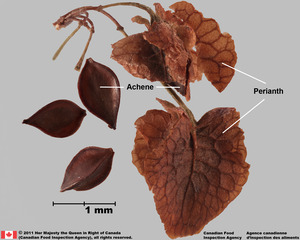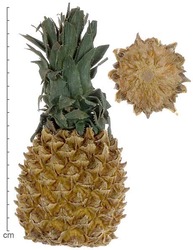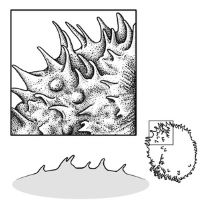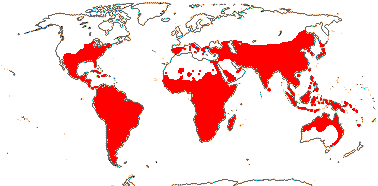Family Name: Moraceae Gaudichaud-Beaupré
Synonym(s): Artocarpaceae Bercht. & J. Presl; Ficaceae Bercht. & J. Presl
Common Name(s): mulberry family
*Number of genera/species: 38/1,180
List of genera records in GRIN-Global
Infructescenceinfructescence:
mature (fruiting) inflorescence
a fleshy receptacle enclosing a drupe(s) or achenesachene:
a dry, indehiscent, one-seeded fruit, with seed attached to pericarp at a single point, derived from a single, superior, simple or compound, one-loculed ovary and enveloped within a persistent, fleshy perianthperianth:
and enveloped within a persistent, fleshy perianthperianth:
collective term for calyx and corolla of a flower
 , and sometimes with hardened or fleshy bracts. Infructescence globose, hemisphericalhemispherical:
, and sometimes with hardened or fleshy bracts. Infructescence globose, hemisphericalhemispherical:
2D shape—shaped like half a sphere
, ellipsoidellipsoid:
3D shape—elliptic
, pear-shaped, ovoidovoid:
3D shape—ovate , oblongoblong:
, oblongoblong:
2D shape—much longer than broad with nearly parallel sides, corners are rounded , or 3-angled, usually 5–200 mm, to 1000 mm in Artocarpus, sometimes crowned by remnants of stamens or staminate flowers. Outer surface gray, black, purple, green, brown, yellow, orange, red, or white, fleshy, sometimes indurateindurate:
, or 3-angled, usually 5–200 mm, to 1000 mm in Artocarpus, sometimes crowned by remnants of stamens or staminate flowers. Outer surface gray, black, purple, green, brown, yellow, orange, red, or white, fleshy, sometimes indurateindurate:
texture—hardened or stony; yielding under strong pressure; not deformable without internal structural disruption
, glabrousglabrous:
without hairs
or pubescentpubescent:
surface relief—bearing hairs
, smooth, ribbedribbed:
surface relief—wide, prominent, linear ridges that are generally rounded and longitudinally situated on the surface , ridgedridged:
, ridgedridged:
surface relief—raised, thick ridges, sharp edged or rounded, usually in a series that may cover the entire surface , muricatemuricate:
, muricatemuricate:
surface relief—rough with small, hard, sharp projections
, wartywarty:
surface relief—distinct, rounded projections that are large relative to the fruit size; tuberculate, verrucose , wrinkledwrinkled:
, wrinkledwrinkled:
surface relief—shallow, irregular folds and furrows covering the surface; appearing overall though crumpled and then spread out , or with irregularly shaped protuberances, sometimes covered by indurateindurate:
, or with irregularly shaped protuberances, sometimes covered by indurateindurate:
texture—hardened or stony; yielding under strong pressure; not deformable without internal structural disruption
tips of floral bracts appearing echinate. In some genera, deciphering between perianthperianth:
collective term for calyx and corolla of a flower
 , bracts, and axialaxial:
, bracts, and axialaxial:
(of embryo) embryo is situated along the longitudinal axis of the seed and may partially or completely fill the seed
tissue (e.g. Artocarpus, Paratocarpus) is difficult. Milky sap often present.
Fruit usually a drupedrupe:
(indehiscent drupe) a fleshy, indehiscent fruit with one more hard pits enclosing seeds, derived from single, superior, simple or compound ovary; (dehiscent drupe) a fruit with a dry or fibrous to fleshy or leathery outer husk that early to tardily breaks apart (or opens), exposing one or more nutlike pits enclosing the seeds , indehiscentindehiscent:
, indehiscentindehiscent:
not opening on its own, as in a fruit
 or dehiscentdehiscent:
or dehiscentdehiscent:
(v. dehisce) splitting open at maturity to release contents (of a fruit) , free or adnate to fleshy, persistent perianthperianth:
, free or adnate to fleshy, persistent perianthperianth:
collective term for calyx and corolla of a flower
 . Fruits free or connate to each other, enclosed or not in receptacle and/or floral bracts to form a unit syncarpsyncarp:
. Fruits free or connate to each other, enclosed or not in receptacle and/or floral bracts to form a unit syncarpsyncarp:
fruit derived from fusion of numerous ovaries in a many-flowered inflorescence ) syconium), sometimes achenesachene:
) syconium), sometimes achenesachene:
a dry, indehiscent, one-seeded fruit, with seed attached to pericarp at a single point, derived from a single, superior, simple or compound, one-loculed ovary within a syconium (Fatoua, neotropical Ficus spp.). Fruits usually 2–30 mm, rarely to 60 mm, globoseglobose:
within a syconium (Fatoua, neotropical Ficus spp.). Fruits usually 2–30 mm, rarely to 60 mm, globoseglobose:
3D shape—more or less spherical , lens-shapedlens-shaped:
, lens-shapedlens-shaped:
2D shape—round and flattened with two curved (convex) surfaces
, ellipsoidellipsoid:
3D shape—elliptic
, ovoidovoid:
3D shape—ovate , or reniformreniform:
, or reniformreniform:
2D or 3D shape—kidney-shaped , tereteterete:
, tereteterete:
approximately circular in cross section; width and thickness approximately equal
 in transection, with 2 persistent stylesstyle:
in transection, with 2 persistent stylesstyle:
in a flower, the narrow and elongated part of the pistil between the stigma and the ovary; sometimes persisting in fruit , with one seed. Pericarppericarp:
, with one seed. Pericarppericarp:
fruit wall or fruit coat
brown, yellow, red, or white, rarely blue, dulldull:
reflecting only a low proportion of incident light, with no apparent sheen , usually fleshy, glabrousglabrous:
, usually fleshy, glabrousglabrous:
without hairs
, smooth or wrinkledwrinkled:
surface relief—shallow, irregular folds and furrows covering the surface; appearing overall though crumpled and then spread out or wartywarty:
or wartywarty:
surface relief—distinct, rounded projections that are large relative to the fruit size; tuberculate, verrucose .
.
DrupesDrupe:
(indehiscent drupe) a fleshy, indehiscent fruit with one more hard pits enclosing seeds, derived from single, superior, simple or compound ovary; (dehiscent drupe) a fruit with a dry or fibrous to fleshy or leathery outer husk that early to tardily breaks apart (or opens), exposing one or more nutlike pits enclosing the seeds free of perianthperianth:
free of perianthperianth:
collective term for calyx and corolla of a flower
 are dehiscentdehiscent:
are dehiscentdehiscent:
(v. dehisce) splitting open at maturity to release contents (of a fruit) with exocarpexocarp:
with exocarpexocarp:
outer layer of fruit wall or pericarp, if divided into layers; note here used synonymously with epicarp splitting open to expose or eject endocarpendocarp:
splitting open to expose or eject endocarpendocarp:
the inner layer of the pericarp, if divided into layers . Exocarpexocarp:
. Exocarpexocarp:
outer layer of fruit wall or pericarp, if divided into layers; note here used synonymously with epicarp fleshy, crustaceouscrustaceous:
fleshy, crustaceouscrustaceous:
texture—thin, dry, indurate, and brittle
or membranousmembranous:
texture—extremely thin, pliable, and fairly tough
. Endocarpendocarp:
the inner layer of the pericarp, if divided into layers is usually shaped like the drupedrupe:
is usually shaped like the drupedrupe:
(indehiscent drupe) a fleshy, indehiscent fruit with one more hard pits enclosing seeds, derived from single, superior, simple or compound ovary; (dehiscent drupe) a fruit with a dry or fibrous to fleshy or leathery outer husk that early to tardily breaks apart (or opens), exposing one or more nutlike pits enclosing the seeds , sometimes tetrahedral, usually crustaceouscrustaceous:
, sometimes tetrahedral, usually crustaceouscrustaceous:
texture—thin, dry, indurate, and brittle
, sometimes woodywoody:
texture—consisting mainly of indurate lignified tissues, characteristic of or resembling wood
or leatheryleathery:
texture—moderately thick, tough, and very pliable
, smooth or tuberculatetuberculate:
surface relief—bearing small, warty, swelling, rounded, or variously shaped projections .
.
Seeds globoseglobose:
3D shape—more or less spherical , ovoidovoid:
, ovoidovoid:
3D shape—ovate , oblongoblong:
, oblongoblong:
2D shape—much longer than broad with nearly parallel sides, corners are rounded , or lens-shapedlens-shaped:
, or lens-shapedlens-shaped:
2D shape—round and flattened with two curved (convex) surfaces
, tereteterete:
approximately circular in cross section; width and thickness approximately equal
 in transection, 1.5–20 mm long. Seed coat brown, yellow, or red, thin and fleshy, crustaceouscrustaceous:
in transection, 1.5–20 mm long. Seed coat brown, yellow, or red, thin and fleshy, crustaceouscrustaceous:
texture—thin, dry, indurate, and brittle
, or membranousmembranous:
texture—extremely thin, pliable, and fairly tough
or hard, glabrousglabrous:
without hairs
, smooth or wartywarty:
surface relief—distinct, rounded projections that are large relative to the fruit size; tuberculate, verrucose , minutely striated or pittedpitted:
, minutely striated or pittedpitted:
surface relief—surface with small depressions in which the areas between the hollows do not take on the appearance of a true reticular net , papillosepapillate:
, papillosepapillate:
surface relief—bearing minute, distinct, broad-based projections, tapering to a rounded apex , wrinkledwrinkled:
, wrinkledwrinkled:
surface relief—shallow, irregular folds and furrows covering the surface; appearing overall though crumpled and then spread out , or with conspicuous venation, especially near hilahilum:
, or with conspicuous venation, especially near hilahilum:
on seeds, the scar indicating where the funiculus was attached; on grass caryopses, the scar visible on the outer fruit surface revealing where the seed is attached on the inner fruit wall surface; or in Asteraceae cypselae, the scar visible on the outer fruit wall revealing where the fruit was attached to the receptacle . Hila larger than punctatepunctate:
. Hila larger than punctatepunctate:
surface relief—dotted with pits or with translucent, sunken glands or with colored dots, similar to pitted , often marginalmarginal:
, often marginalmarginal:
at, on, or close to the margin or border
and peltate.
Embryo well-developed, completely to nearly filling seed cavity, axileaxile:
on or of the axis
and centric, foliatefoliate:
appearing leaf-like
, straight or curvedcurved:
(of embryo) linear embryo is curved into an arch or horseshoe with the ends far apart , sometimes green, cotyledons usually thick and equal or unequal.
, sometimes green, cotyledons usually thick and equal or unequal.
Endosperm absent in large seeds, present, fleshy in small seeds.
| Fruit | |
| Type | usually drupedrupe: (indehiscent drupe) a fleshy, indehiscent fruit with one more hard pits enclosing seeds, derived from single, superior, simple or compound ovary; (dehiscent drupe) a fruit with a dry or fibrous to fleshy or leathery outer husk that early to tardily breaks apart (or opens), exposing one or more nutlike pits enclosing the seeds  , rarely acheneachene: , rarely acheneachene:a dry, indehiscent, one-seeded fruit, with seed attached to pericarp at a single point, derived from a single, superior, simple or compound, one-loculed ovary  |
| Size range | 2–30 mm, rarely to 60 mm long |
| Shape(s) | globoseglobose: 3D shape—more or less spherical  , lens-shapedlens-shaped: , lens-shapedlens-shaped:2D shape—round and flattened with two curved (convex) surfaces , ellipsoidellipsoid: 3D shape—elliptic , ovoidovoid: 3D shape—ovate  , reniformreniform: , reniformreniform:2D or 3D shape—kidney-shaped  |
| Texture | fleshy |
| Surface relief | smooth, wrinkledwrinkled: surface relief—shallow, irregular folds and furrows covering the surface; appearing overall though crumpled and then spread out  , wartywarty: , wartywarty:surface relief—distinct, rounded projections that are large relative to the fruit size; tuberculate, verrucose  |
| Color(s) | brown, yellow, red, white, rarely blue |
| Unique features | Usually one-seeded, drupaceous fruits (fleshy portion derived from adnate persistent, fleshy perianthperianth: collective term for calyx and corolla of a flower  ), which disperse individually or together (infructescenceinfructescence: ), which disperse individually or together (infructescenceinfructescence:mature (fruiting) inflorescence ). InfructescencesInfructescence: mature (fruiting) inflorescence usually globoseglobose: 3D shape—more or less spherical  or hemisphericalhemispherical: or hemisphericalhemispherical:2D shape—shaped like half a sphere , green, yellow, or orange, fleshy, and appear groovedgrooved: surface relief—linear depressions that may be single or form a series of grooves over the surface  , wrinkledwrinkled: , wrinkledwrinkled:surface relief—shallow, irregular folds and furrows covering the surface; appearing overall though crumpled and then spread out  , or with protuberances (wartywarty: , or with protuberances (wartywarty:surface relief—distinct, rounded projections that are large relative to the fruit size; tuberculate, verrucose  or spinyspiny: or spinyspiny:having slender, stiff, sharp projections oriented in the general plane of the structure  ). If drupesdrupe: ). If drupesdrupe:(indehiscent drupe) a fleshy, indehiscent fruit with one more hard pits enclosing seeds, derived from single, superior, simple or compound ovary; (dehiscent drupe) a fruit with a dry or fibrous to fleshy or leathery outer husk that early to tardily breaks apart (or opens), exposing one or more nutlike pits enclosing the seeds  free from fleshy perianthperianth: free from fleshy perianthperianth:collective term for calyx and corolla of a flower  , then dehiscentdehiscent: , then dehiscentdehiscent:(v. dehisce) splitting open at maturity to release contents (of a fruit)  , and endocarpendocarp: , and endocarpendocarp:the inner layer of the pericarp, if divided into layers  is the diaspore. is the diaspore. |
| Seed | |
| Size range | 1.5–20 mm long |
| Shape(s) | globoseglobose: 3D shape—more or less spherical  , ovoidovoid: , ovoidovoid:3D shape—ovate  , oblongoblong: , oblongoblong:2D shape—much longer than broad with nearly parallel sides, corners are rounded  , lens-shapedlens-shaped: , lens-shapedlens-shaped:2D shape—round and flattened with two curved (convex) surfaces |
| Surface relief | smooth, wartywarty: surface relief—distinct, rounded projections that are large relative to the fruit size; tuberculate, verrucose  , minutely striated or pittedpitted: , minutely striated or pittedpitted:surface relief—surface with small depressions in which the areas between the hollows do not take on the appearance of a true reticular net  , papillosepapillate: , papillosepapillate:surface relief—bearing minute, distinct, broad-based projections, tapering to a rounded apex  , wrinkledwrinkled: , wrinkledwrinkled:surface relief—shallow, irregular folds and furrows covering the surface; appearing overall though crumpled and then spread out  , with conspicuous venation , with conspicuous venation |
| Color(s) | brown, yellow, red |
| Other | |
| Embryo | well-developed, completely to nearly filling seed cavity, axileaxile: on or of the axis and centric, foliatefoliate: appearing leaf-like , straight or curvedcurved: (of embryo) linear embryo is curved into an arch or horseshoe with the ends far apart  , sometimes green, cotyledons usually thick and equal or unequal , sometimes green, cotyledons usually thick and equal or unequal |
| Nutritive tissue | endosperm absent in large seeds or present and fleshy in small seeds |
Tropical and subtropical regions, with a few members in temperate regions

Distribution map courtesy of Angiosperm Phylogeny Website.
Berg 2001Berg 2001:
Berg CC. 2001. Moreae, Artocarpeae, and Dorstenia (Moraceae), with introductions to the family and Ficus and with additions and corrections to Flora Neotropica Monograph 7. Flora Neotropica 83: iii–346. http://www.jstor.org/stable/4393905; Berg and Hijman 1989Berg and Hijman 1989:
Berg CC and Hijman MEE. 1989. Moraceae. In: Flora of Tropical East Africa. Vol 117. AA Balkema, Rotterdam, Netherlands. 96 pp.; Bingham et al. 2021+Bingham et al. 2021+:
Bingham MG, Willeman A, Wursten BT, Ballings P, and Hyde MA. 2021. Flora of Zambia. Accessed January 2021–April 2024. URL: https://www.zambiaflora.com; Davidse et al. 2009–2018Davidse et al. 2009–2018:
Davidse GM, Sousa Sánchez M, Knapp S. and Chiang Cabrera F, eds. 2009–2018. Flora Mesoamericana. Missouri Botanical Garden, St. Louis, MO. Accessed: January–April 2024. URL: http://legacy.tropicos.org/Project/FM; Flora of Australia 2021+Flora of Australia 2021+:
Flora of Australia. Australian Biological Resources Study, Canberra. Accessed January 2021–March 2024. URL: http://www.ausflora.org.au; Flora of North America Editorial Committee 1993+Flora of North America Editorial Committee 1993+:
Flora of North America Editorial Committee, eds. 1993+. Flora of North America North of Mexico [Online]. 22+ vols. Flora of North America Association, New York and Oxford. Accessed January-March 2024. URL: http://beta.floranorthamerica.org.; Hyde et al. 2021b+Hyde et al. 2021b+:
Hyde MA, Wursten BT, Ballings P, and Coates Palgrave M. 2021b. Flora of Mozambique. Accessed January 2021–April 2024. URL: https://www.mozambiqueflora.com/index.php; Hutchinson and Dalziel 1954–1972Hutchinson and Dalziel 1954–1972:
Hutchinson J and Dalziel JM, revised by Keay RWJ and Hepper FN. 1954–1972. Flora of West Tropical Africa, ed. 2, 3 Vols. 2300 pp.; Kirkbride et al. 2006Kirkbride et al. 2006:
Kirkbride JH, Jr, Gunn CR, and Dallwitz MJ. 2006. Family guide for fruits and seeds, vers. 1.0. Accessed September 2020-January 2022. URL: https://nt.ars-grin.gov/seedsfruits/keys/frsdfam/index.cfm .; Kubitzki et al. 1990+Kubitzki et al. 1990+:
Kubitzki K et al., eds. 1990+. The families and genera of vascular plants. 7+ vols. Berlin etc.; Lentz and Dickau 2005Lentz and Dickau 2005:
Lentz DL and Dickau R. 2005. Seeds of Central America and Southern Mexico: The Economic Species. The New York Botanical Garden Press, New York. 298 pp.; Nooteboom et al. 2021+Nooteboom et al. 2021+:
Nooteboom HP, de Wilde WJJO, Stevens PF, Coode MJE, and Saw LG. 2021+ Flora Malesiana Online. Accessed January 2021–March 2024. URL: https://portal.cybertaxonomy.org/flora-malesiana/; Takhtajan 2009Takhtajan 2009:
Takhtajan A. 2009. Flowering plants: Second edition. Springer Nature, Switzerland. 871 pp.; Tutin et al. 1964–1980Tutin et al. 1964–1980:
Tutin TG, Burges NA, Chater AO, Edmondson JR, Heywood VH, Moore DM, Valentine DH, Walters SM, and Webb DA (eds.) 1964–1980. Flora Europaea. 5 vols. Cambridge University Press, Cambridge UK. 2,524 pp.; Zhengyi et al. 2004+Zhengyi et al. 2004+:
Zhengyi W, Raven PH, and Deyuan H. 2004+. Flora of China [online]. 25 vols. Science Press, Beijing China & Missouri Botanical Garden, St. Louis USA. Accessed January–March 2024. http://flora.huh.harvard.edu/china/; Zich et al. 2020Zich et al. 2020:
Zich FA, Hyland BPM, Whiffin T, and Kerrigan RA. 2020. Australian Tropical Rainforest Plants. Edition 8. Accessed November 2023. URL: https://apps.lucidcentral.org/rainforest/text/intro/index.html
*The number of genera and species is based on Christenhusz and Byng 2016Christenhusz and Byng 2016:
Christenhusz MJM and Byng JW. 2016. The number of known plant species in the world and its annual increase. Phytotaxa 261 (3): 201-217. https://doi.org/10.11646/phytotaxa.261.3.1, which may differ from the number of genera in GRIN-Global.